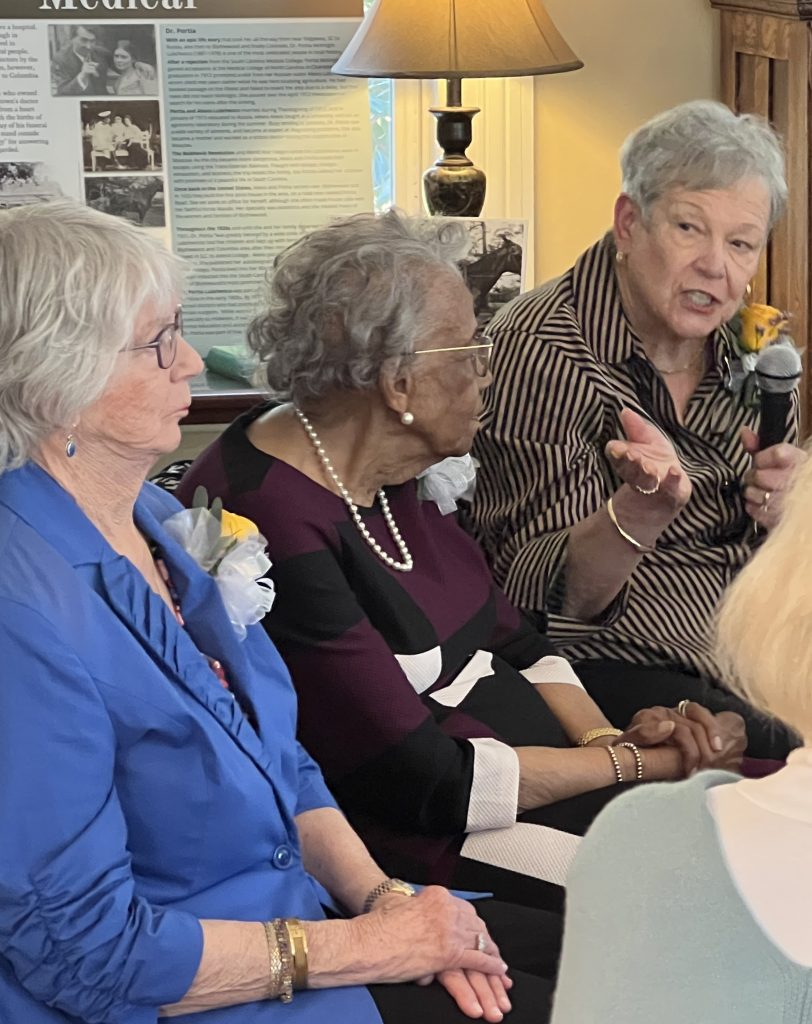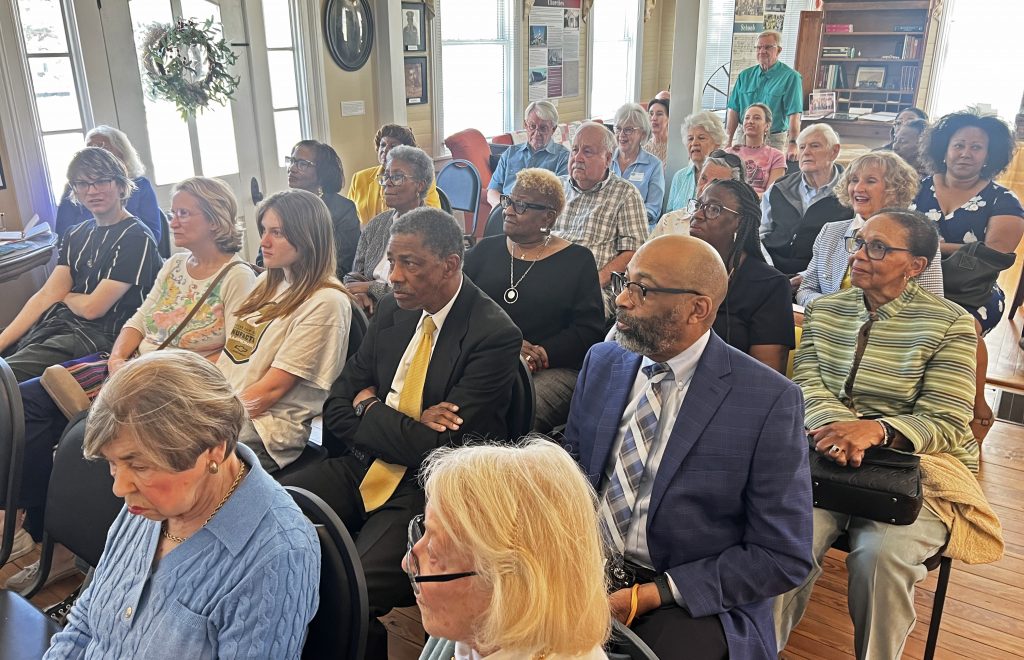
BLYTHEWOOD – Margaret Creech DuBard, 83, Mattie Robertson-Squirewell, 95, and Ann Lang-ford Mattox, 82, all grew up in Blythewood, loosely connected, but worlds apart. When she was 13, Mattie – who lived on Sandfield Road – began babysitting Ann, barely two years old. Ann’s family lived in the Hoffman House (now town hall). Several years later when they moved into a new red brick house on Main Street where the new car wash now stands. Margaret’s family lived next door in their grandmother’s large house that still stands next to the new car wash. Margaret said her friendship with Ann turned into a sistership over the years and continues to-day.
As the three girls grew up in Blythewood, their experiences were different. They have different memories and different stories to tell of the way things were, growing up in Blythewood.
On Sunday, March 23, during the Blythewood Historical Society’s celebration of Women’s History Month the community was invited to hear the three women talk about what it was like growing up in Blythewood in the 1940’s, 50’s, and 60’s.

Blythewood Attorney and member of the Blythewood Historical Society Board, Bob Wood, moderated the discussion. He began by asking each woman, “Who was your father?”
Margaret Creech DuBard
“My daddy was J. R. Creech. He owned the Gulf service station that’s still in operation – now a BP station – [next to Blythewood Consignment] on Main Street,” Margaret said. Over the years, Creech acquired much of the land that now comprises downtown Blythewood. Margaret and her family spent most of her childhood living with their grandmother who owned a large home that had been a popular boarding house. It was located on Main Street (Hwy 21) next door to the red brick home where Ann’s family lived. The red brick house was recently torn down and replaced with a car wash business. Margaret’s grandmother’s house still stands today next to the new carwash.
“Ann and I grew up best friends. We went all through school together, and my sisters and I always called Ann our fourth Creech sister,” Margaret said.
At that time, Margaret said, the town limits were a circle – everything was within a quarter mile of the depot which was located approximately where Doko Station restaurant is located across from the front of town hall.
She talked about her Aunt Virginia Boney who had a farm in downtown Blythewood and milked two cows twice a day. She talked about her sister Linda being the Town’s mayor at one time, and also how she (Margaret) after only a year and a half of college, and with just one class in library studies completed, took a job as a librarian at Richard Winn Academy in Winnsboro, a position she held for 20 years.
“Blythewood was a close knit town,” Margaret said. “People looked out for each other. I was always proud to say I was from Blythewood. People were close and knew each other,” she said. “I may be wrong, but with most families in Blythewood, the two races have gotten along very well and respected each other. That’s what I saw growing up. I’m not sure that was really the case, but we were always taught to respect people.
Mattie Robertson-Squirewell
“My daddy was George Robertson,” Mattie recalled. “I was born on the property where The Farm is now. My daddy was sharecropping there. We later moved to Sandfield Road. One day, my daddy came home and told Mama that Buddy Langford asked him about me babysitting Ann who was about two years old. Her family lived in the Hoffman House. Mama agreed, so I babysat Ann after school every day so her Mama could go to the library or do whatever she wanted to do.
They paid me 50 cents a week,” she said. That was a lot of money back then.”
Asked by Wood if she was happy with how women were treated when she was growing up and about the role of women then and their opportunities.
“I’m glad things have changed to what it is today,” she said. “It’s like night and day, because when I was growing up it was still that whites had privileges that blacks didn’t have. When I babysat Ann, I could go in the back door to the Hoffman House,” she said, “but I couldn’t go in the front door. But I could open the front door to sweep the front porch and the steps and then go back in. But when I went to their house to babysit, I had to go in the back door.”
Asked by Wood, how that made her feel, she replied, “I wasn’t comfortable with it, but that’s just the way it was.
“And since you asked,” Mattie said, “Back in the 40’s, when blacks got a chance to register to vote, my daddy went around getting signatures, registering black people, and after he did that, they burned down our barn – the Ku Klux Klan – burned our barn down, a mule and a horse burned up,” she said in a quiet but steady voice without spite or drama. “Then a few years later, on a Saturday night, someone knocked on our door about 12 o’clock at night and said ‘George, wake up. There’s a cross burning in your yard.’ So, we lived in that, but we tried not to let it stop us. We just tried to do more and be stronger.
“When I was coming along, most women’s jobs were to keep house and raise the children. But a lot of them wanted better, for their children to go to school and to get a job,” Mattie said. “I always thought we needed to do better with everything for the children to make progress.”
In a recorded video that was shown on a screen at the front of the room, Mattie said:
“I would like to say to everybody, the best thing you can do is believe in Jesus Christ and always instill in your family to put God first, and you’ll be blessed. I know I’ve been blessed. I’ll be 95 this Friday.”
Anne Langford Mattox
“My daddy was Buddy Langford, and he worked in the Wilson’s Grocery Store,” Ann recalled. The Blythewood Scrapbook described Buddy Langford as, a charming man who had a frank manner, and at one time, “he was quite active in clearing out the undesirable elements of Blythewood.” Ann remembers her father fondly and worked in the grocery story with him from a young age.
“I started working in the store for $1 a week when I was in fourth grade. I worked there most every day until I went to Carolina (University of South Carolina.) When I left, I said I would never work in a grocery store again,” she said with a laugh. When she graduated from USC with a degree in business, she got married, got a job and moved to Columbia, then Lake Murray, and she now lives in Peak, on the Broad River.
Ann talked about her favorite Aunt Catherine who got married, had children, and moved away to Florida and New York, but loved coming back to Blythewood to ride in the back of Buddy Langford’s truck. She also talked about how in the 1950’s and 60’s not many people in Blythewood went to college, but went to work instead.
Final Comments
After Mattie related the story of her family’s barn and a cross being burned, Margaret and Ann addressed the subject.
“We knew and felt as children that the way colored people were treated was not right,” Margaret said. “When I graduated from high school, I read a book named ‘To Kill a Mocking Bird.’ It was very valuable to me, and illustrated that race relations were not fair and that things needed to change.”
“It [burning of the cross] was the saddest moment of Blythewood’s history to me,” Ann recalled. “It was terrible. I did not know the people involved. I would not want to know the people involved. But I know it wasn’t my daddy because he cut hair two nights a week in the back of the store and he was home the rest of the time,” she said. “He worked seven days a week – including the weekends – in the store, keeping it clean. But that is some of Blythewood’s town history and needs to be told.”












